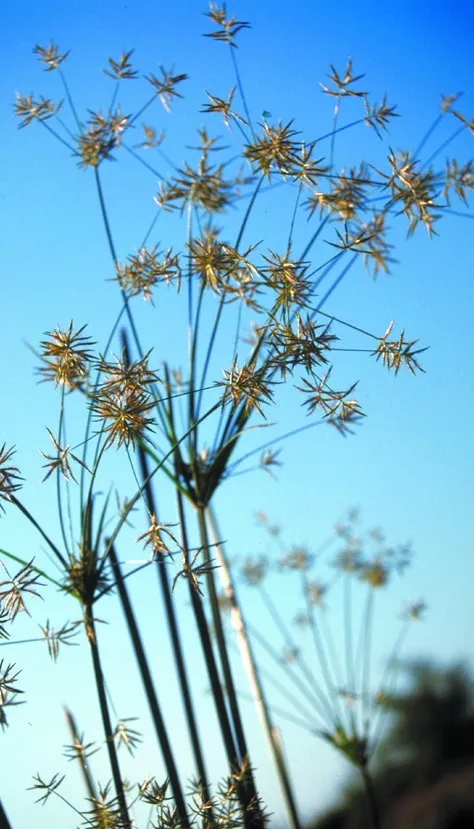Sharon Nut-grass
Cyperus sharonensis



Cyperus sharonensis grows in only in three regions along the coastal plain: Carmel Beach, Sharon and the Philistine Plain. Its habitat in Israel is exclusively sands, which limits its distribution to the beaches and adjacent areas on the coast. It is common on the Carmel Beach and on the Sharon sands, but these sandy areas are rapidly shrinking due to construction and development. In these regions, about 50 sites were surveyed in recent years. In the past there were large populations in Caesarea, but after the construction of the golf club C. sharonensis became scarce in the region. In the Philistine Plain, the plant is rare, and has been replaced, in the same habitat, by C. capitatus.
Semi-stabilized sand expanses on the coastal plain near the sea, up to 1.5 km from the coastline. Grows in areas exposed to the sun in open plant communities whose cover is less than 30 percent.
Cyperus sharonensis was recently described as a new species. It is closely related and very similar to C. capitatus, and it is even possible that it developed from it during the evolution of the coastal plain in the Pleistocene era. C. sharonensis differs from C. capitatus by the size of its inflorescence (the diameter of the corolla 4-5 cm) and by its general size. Whereas C. sharonensis grows only on the coastal plain sands, C. capitatus is a plant of desert sands, growing mainly in the sands of the western Negev, but also throughout the coastal plain sands, including the sands of Haifa Bay and to the north. In other endemic plants of the coastal plain, it is also possible to detect their vicarious species geographically close by (Shmida, 1984; Auerbach and Shmida, 1987). According to Danin (Danin and Kukkonen, 1995; Danin 2004) this suggests that they are close geologically. However, C. sharonensis and C. capitatus have a sympatric distribution in Israel, in all three regions (Carmel Beach, Sharon and Philistine Plain) in their range, and they do not have an allopatric distribution, as do other coastal plain endemics.
C. sharonensis belongs to an ecological group of Cyperus species that grow on sands and not on wetlands, like C. capitatus and C. macrorrhizus.
• The sandy habitats of the Carmel Beach and the Sharon are disappearing, and the Cyperus sharonensis populations are becoming extinct.
• The sites on which C. sharonensis grows are subject to sand quarrying, road development, off-road vehicles (ORVs) and to intensive recreational pressure. Access to these sites is very easy.
• The sandy habitats of the coastal plain are becoming more fragmented and populations are often hundreds of meters or several kilometers apart.
• The population size at the various sites ranges from several hundred to thousands.
A central population site should be declared at the Caesarea sands, where there were once large Cyperus sharonensis populations (landowners should be pressured to allocate it for a nature reserve). The two populations in Caesarea and the Palmahim Sands should be monitored (the Wadi Poleg Reserve is the third priority).
Cyperus sharonensis is endemic to Israel and limited to the coastal plain.
Cyperus sharonensis is endemic to the coastal plain in Israel, growing in several dozen sites in three regions. Its classification as a red plant reflects its endemic distribution and the current severe threat to the coastal region sandy habitat that is rapidly becoming extinct. The development of the sandy areas and the uncontrolled quarrying of sand have led to a drastic reduction of C. sharonensis populations and severely endanger the species.
Danin, A. and Kukkonen, I. 1995. A new Contributions to the flora of Israel. VIII. A new Cyperus from Israel Cyperus sharonensis Danin et Kukkonen sp. n. Israel J. Pl. Sci. 43:
77-82.
Current Occupancy Map
| 1000 squre meter pixel | 5000 squre meter pixel | 10000 squre meter pixel | |
|---|---|---|---|
| number of observations | 0 | 0 | 0 |
| in total pixels | 0 | 0 | 0 |
| Family | Cyperaceae |
| Classification | On the endangered species list |
| Ecosystem | Coastal area |
| Chorotype | Eastern Mediterranean (Endemic) |
| Conservation Site | Caesarea Sands |
| Rarity |
1
1
6
|
|---|---|
| Vulnerability |
0
1
4
|
| Attractiveness |
0
0
4
|
| Endemism |
0
4
4
|
| Red number |
1
3.2
10
|
| Peripherality | 0 |
| IUCN category | DD EW EX LC CR EN VU NT |
| Threat Definition according to the red book | Vulnerable |
 Based on:
Based on:






